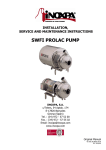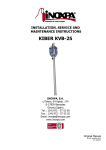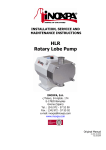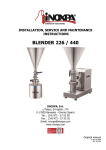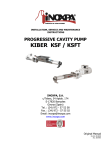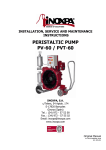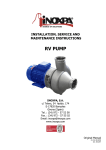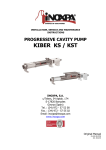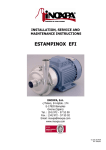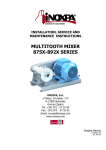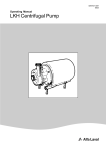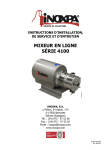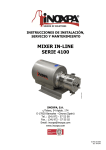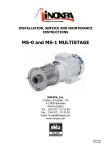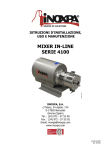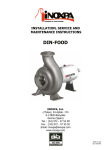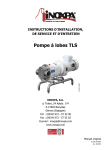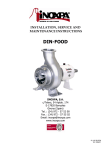Download IN-LINE MIXER 4100 SERIES
Transcript
INSTALLATION, SERVICE AND MAINTENANCE INSTRUCTIONS 03.400.32.0001 IN-LINE MIXER 4100 SERIES INOXPA, S.A. c/Telers, 54 Aptdo. 174 E-17820 Banyoles Girona (Spain) Tel. : (34) 972 - 57 52 00 Fax. : (34) 972 - 57 55 02 Email: [email protected] www.inoxpa.com 03.400.30.00EN (B) 2015/01 EC Declaration of Conformity The manufacturer: INOXPA, S.A. c/ Telers, 57 17820 Banyoles (Girona), Spain herewith declares that the machine: ME-4100 Mixer with the serial number: ________________ conforms to the relevant provisions of the following directives: Machinery Directive 2006/42/EC (RD 1644/2008) Low voltage Directive 2006/95/EC Electromagnetic Compatibility Directive 2004/108/EC Applicable harmonised Standards: UNE-EN ISO 12100:2012 Identification of the person empowered to draw up the Declaration on behalf of the manufacturer, and qualified to compile the technical file established by the Community: Banyoles, 8 January 2014 David Reyero Brunet Technical Office Manager 1. Safety 1.1. INSTRUCTIONS MANUAL This instruction manual contains information on the reception, installation, operation, fitting, stripping and maintenance for the In-line Mixer. The information given herein is based on the most up-to-date data available. INOXPA reserves the right to modify this instructions manual without having to give prior notice. 1.2. START-UP INSTRUCTIONS This instruction manual contains vital and useful information for properly operating the mixer and for keeping it in good running condition. Not only should the safety instructions set forth in this chapter be carefully read before putting the mixer into operation, but those concerned must also familiarize themselves with the operating features of the mixer and strictly adhere to the instructions given herein. It is extremely important that these instructions be kept in a set place near the installation. 1.3. SAFETY 1.3.1. Warning signs Danger for people in general Danger of injury caused by rotating parts of the equipment Danger! Electricity Danger! Caustic or corrosive agents Danger! Suspended loads Danger to the proper operating of the machine Obligation to ensure safety at work Use safety goggles obligatory 1.4. GENERAL SAFETY INSTRUCTIONS Please read the instruction manual carefully before installing and commissioning the mixer. Should you have any doubts o queries, contact INOXPA. This equipment is suitable for his use in food process. 1.4.1. During the installation You must always bear in mind the Technical Specifications set forth in Chapter 8. Do not put the mixer into operation before connecting it to the pipes. Do not put the mixer into operation if the cover of the mixer has not been fitted and the impeller fixed in the mixer. Check that the motor specifications are correct, especially if there is a special risk of explosion due to the work conditions. During the installation procedure, all the electrical work must be carried out by duly authorized personnel. 1.4.2. During operation You must always bear in mind the Technical Specifications set forth in Chapter 8. The limit values that have been set must NEVER be exceeded. NEVER touch the mixer or pipes whenever the mixer is being used to decant hot liquids or during the cleaning procedure. 2015/01 1.Safety 3 The mixer has moving parts. Do not put your fingers into the mixer when it is operating. NEVER work with the suction and the delivery valves shut off. NEVER directly sprinkle the electric motor with water. Standard motor protection is IP-55: dust and water sprinkling protection. 1.4.3. During maintenance You must always bear in mind the Technical Specifications set forth in Chapter 8. NEVER strip the mixer down until the pipes have been drained. Remember that there will always be some liquid left in the mixer casing (if it has not been fitted with a drain). Always remember that the liquid that has been mixed may be dangerous or subject to high temperatures. For situations of this type, please consult the prevailing regulations in the country in question. Do not leave loose parts on the floor. ALWAYS turn the power supply to the mixer off before embarking on maintenance work. Take out the fuses and disconnect the wires. All electrical work must be carried out by duly authorized personnel. 1.4.4. In accordance with the instructions Any failure to comply with the instructions could lead to a hazard for the operators, the atmospheric conditions of the room, and the machine, and it could lead to a loss to any right to make a claim for damages. Such non-compliance could bring with it the following risks: Important operating failures of the machine / plant. Failure to comply with specific maintenance and repair procedures. Potential electrical, mechanical and chemical hazards. Atmospheric conditions in the room could be hazardous due to the release of chemical substances. 1.4.5. Warranty We wish to point out that any warranty issued will be null and void and that we are entitled to an indemnity for any civil liability claim for products which might be filed by third parties if: Operation and maintenance work has not been done following the corresponding instructions; the repairs have not been made by our personnel or have been made without our written authorization; Modifications are made to our material without prior written authorization; The parts or lubricants used are not original INOXPA parts/lubricants; The material has been improperly used due to error or negligence or have not been used according to the indications and the intended purpose. The parts of the mixer have been damaged as a result of having been exposed to strong pressure as there was no safety valve. The General Delivery Terms which you have already received are also applicable. No modification can be made to the machine without the prior consent of the manufacturer. For your safety, use spare parts and original accessories. The use of other parts exempts the manufacturer from any and all responsibility. Any change in operating conditions can only be done with the prior written consent of INOXPA. In the event of doubt or should you require a fuller explanation on particular data (adjustment, assembly, disassembly...), please do not hesitate to contact us. 4 1.Safety 2015/01 2. Index 1. Safety 1.1. Instructions manual ......................................................................................................... 3 1.2. Start-up instructions ........................................................................................................ 3 1.3. Safety ............................................................................................................................. 3 1.4. General safety instructions ............................................................................................... 3 2. Index 3. General Information 3.1. Description...................................................................................................................... 7 3.2. Operating principle .......................................................................................................... 7 3.3. Application ...................................................................................................................... 7 3.4. Hygiene .......................................................................................................................... 7 3.5. Construction materials ..................................................................................................... 7 4. Installation 4.1. Mixer reception ............................................................................................................... 8 4.2. Transport and storage ..................................................................................................... 8 4.3. Location .......................................................................................................................... 9 4.4. Pipes .............................................................................................................................. 9 4.5. Pressurised tank .............................................................................................................. 9 4.6. Electric installation ..........................................................................................................10 5. Start-up 5.1. Start-up .........................................................................................................................11 6. Operating problems 7. Maintenance 7.1. General maintenance ......................................................................................................13 7.2. Storage ..........................................................................................................................13 7.3. Cleaning ........................................................................................................................13 7.4. Disassembly / assembly of the ME-4101/ 4103/ 4105/ 4110 mixer ....................................14 7.5. Disassembly/ assembly of the ME-4125/4130 mixer ..........................................................19 8. Technical Specifications 8.1. Technical specifications ...................................................................................................24 8.2. Weights .........................................................................................................................24 8.3. ME-4100 Mixer dimensions ..............................................................................................25 8.4. ME-4101/4103/4105/4110 Mixer .....................................................................................26 8.5. ME-4101/4103/4105/4110 Mixer .....................................................................................27 8.6. Parts list ME-4101/4103/4105/4110 Mixer ........................................................................28 8.7. ME-4125/4130 Mixer.......................................................................................................29 8.8. ME-4125/4130 Mixer.......................................................................................................30 2015/01 2.Index 5 8.9. Parts list ME-4125/4130 Mixer ........................................................................................ 31 8.10. ME-4101/4103/4105/4110 Mixer cooled mechanical seal ................................................ 32 8.11. ME-4125/4130 Mixer cooled mechanical seal ................................................................. 33 8.12. ME-4101/4103/4105/4110 Mixer double mechanical seal ................................................ 34 8.13. ME-4125/4130 Mixer double mechanical seal ................................................................. 35 6 2.Index 2015/01 3. General Information 3.1. DESCRIPTION ME-4100 In-line Mixers are compactly built, axially exhausting and radially impelling, while the connections are of the sanitary type. The mixer casing, the rotor and the stator are all mechanised. All of the parts that come into contact with the product are made of stainless steel. The ME-4100 range is designed for continuous operation. Its most significant construction characteristics are as follows: Monoblock execution. Rotor-stator design. Sanitary mechanical seal. B35 Motor. 3.2. OPERATING PRINCIPLE Head suction is produced by the intake mouth. The impeller pushes the product towards the stator, where it is sheared. The product is radially discharged through the stator holes at great speed. Strong circulation is provoked under the surface. It turns in a clockwise direction, when the Mixer is viewed from the rear part of the motor. 3.3. APPLICATION In-line mixers are ideal for processes that require particle reduction, dissolution, dispersion and emulsion. Given its sanitary design, these Mixers are ideal for such demanding industries as the cosmetic, food and pharmaceutical sectors. They can also be used in other ones such as the adhesive, chemical, paints, and plastics industries. 3.4. HYGIENE Special attention has been made in the design of the mixer to the hygiene factor and cleaning possibilities. The number of slots and idle spaces have been reduced to an absolute minimum. The mixer can be cleaned simply and thoroughly in either of the following ways: Without stripping down, for example: by means of steam or water, the so-called Cleaning In Place (CIP) method. Simply by means of stripping the mixer. Refer to Section 7.2 “Cleaning” with respect to how to properly clean the mixer, and the cleaning products that must be used. 3.5. CONSTRUCTION MATERIALS All of the parts of the mixer that come into contact with the product are made of stainless steel, or are made of insipid and odourless materials. This means that the mixer is corrosion proof, which means that the contamination of the liquid being mixed is avoided. During manufacturing, the materials of the parts that come into contact with the product must be checked in order to make sure that they are suitable to house the pumping of food products. Table 3.1: Parts that come into contact with the liquid. Part Material Mixer casing Rotor Stator Mixer cover Motor-shaft Impeller nut AISI AISI AISI AISI AISI AISI 316L 316L 316L 316L 316L 316L (1.4404) (1.4404) (1.4404) (1.4404) (1.4404) (1.4404) Table 3.2: Parts that may come into contact with the liquid. Part Material Lantern 2015/01 AISI 304 3.General Information (1.4308) 7 4. Installation 4.1. MIXER RECEPTION INOXPA is not responsible for any deterioration of the material as a result of its transportation or unpacking. Visually check that the packing has not suffered any damage. The mixer will be accompanied by the following documentation: Dispatch notes. Mixer Instruction and Service Manual. Motor Instruction and Service Manual (*). (*) If the mixer has been supplied with a motor from INOXPA. Unpack the mixer and check the following: The mixer drainage connection and mixer suction and delivery connections, removing the remains of any packing material. 03.400.32.0002 Check that the mixer and the motor have not suffered any damage. Should the mixer not be in proper condition and/or does not have all the parts, the haulier must draw up a report as soon as possible with regard to the same. 4.1.1. Mixer identification and marking 01.011.32.0014 Serial number Mixer Plate 4.2. TRANSPORT AND STORAGE ME-4100 series Mixers are quite often too heavy to be put into their storage space manually. Lift the Mixer as is shown below: Never lift the whole mixer assembly by the mixer casing 8 4.Installation 2015/01 4.3. LOCATION Position the mixer as near as possible to the suction tank, and whenever possible below the level of the liquid. Place the mixer in such a way that there is enough space around it to provide access both to the same and to the motor. (See Chapter 8.Technical specifications to consult dimensions and weights). Place the mixer on a level and flat surface. The basement must be rigid, horizontal and against any vibration. Install the mixer in such a way that it can be properly ventilated. If the mixer is to be installed outside, it must be done so under cover. Its positioning must enable easy access for any inspection and maintenance operations that may need to be carried out. 4.4. PIPES In general, suction and delivery pipes should be fitted in straight stretches, with the minimum amount of elbows and accessories, in order reduce, as far as possible, any pressure loss that might be produced by friction. Make sure that the mixer mouths are well aligned with respect to the piping, and that they are similar in diameter to that of the pipe connections. Position the mixer are near as possible to the suction tank, and whenever possible below the level of the liquid, or even lower with respect to the tank in order for the static suction head be at its maximum. Place brackets for the piping as near as possible to the suction and delivery mouths of the mixer. 4.4.1. Shut-off valves The mixer can be isolated for the purpose of carrying out maintenance work. To this end, shut-off valves should be fitted at the mixer’s suction and delivery connections. These valves must ALWAYS be open whenever the mixer is operating. 4.5. PRESSURISED TANK For models with double mechanical seal will be necessary the installation of a pressure tank. Install ALWAYS the pressure tank between 1 and 2 meters above the mechanical seals. See the figure 4.6.1. 1...2m Connect ALWAYS the refrigeration liquid input connection with the bottom chamber seal connection. So, the refrigeration liquid outlet will be carried out by the top chamber connection. See the figure 4.6.1. Mechanical seal Figure 4.6.1: Pressure tank connection lay out. To obtain further information about the pressure tank (installation, operation, maintenance, … ), consult the instruction manual supplied by the manufacturer. NEVER put the Mixer into operation if the cover has not been fitted and the rotor secured. 2015/01 4.Installation 9 4.6. ELECTRIC INSTALLATION Leave the connecting of the electrical motors to qualified personnel. Take the necessary measures to prevent any breakdowns in the connections and wires. The electrical equipment, the terminals and the components of the control systems may still carry an electric charge even when disconnected. Contact with them may put the safety of operators at risk, or cause irreparable damage to the material. Before maneuvering the mixer, make sure that the electric box is switched off. Connect the motor in accordance with the instructions supplied by the manufacturer of the same. Check the direction of the rotation (see the signaling label on the mixer). NEVER put the Mixer into operation if the cover has not been fitted and the rotor secured. Put the mixer motor into operation momentarily. Make sure, by looking at the mixer from the rear, that the motor’s ventilator is rotating in a clockwise direction. Check ALWAYS the direction of the motor’s rotation with liquid inside the mixer. For the models with sealing chamber, make sure always that it is filed of liquid before checking the rotating direction. 10 4.Installation 2015/01 5. Start-up Before putting the mixer into operation read carefully the instructions on installation given in Chapter 4.Installation 5.1. START-UP Read Chapter 8. Technical Specifications carefully. INOXPA will not assume responsibility for any improper or incorrect use of the equipment. NEVER touch the mixer or the pipes when hot fluid is being mixed. 5.1.1. Checks to be carried out before putting the Mixer into operation Completely open the pipes’ suction and delivery shut-off valves. In the event that the liquid does not flow towards the Mixer, use the feed mixer. The In-line Mixer can overcome a limited delivery pressure. This feed mixer can be used to overcome a possible high delivery pressure. For high viscosity products, a positive displacement feed mixer should be used. The Mixer must NEVER rotate without liquid. Check that the motor turning direction is correct. 5.1.2. Checks to be carried out on putting the Mixer into operation Check to make sure that the Mixer is not making any strange noises. Check to see if the absolute inlet pressure is sufficient, in order to avoid cavitation in the mixer. Monitor the delivery pressure. Check that there are no leaks in the sealed areas. A shut-off valve should not be used in the suction pipe to regulate the flow rate. It must be completely open during operation. Monitor motor consumption in order to avoid a circuit overload. Reduce the flow and the power consumed by the motor: 03.400.32.0003 Regulating the flow to the mixer delivery. Decreasing motor speed. 2015/01 5.Start-up 11 6. Operating problems The table given below provides solutions to problems that might arise during mixer operation. With respect to the same, it is assumed that the mixer has been properly installed and has been correctly selected for the application in question. Should there be a need for technical service please contact INOXPA. Operating incidents Probable causes Overloading of motor. Insufficient flow rate or pressure in mixer. No pressure on the discharge side. Irregular discharge flow rate / pressure. Noise and vibrations. The mixer gets clogged. Overheating of the mixer. Abnormal wear. Leak in mechanical seal. 8, 9, 13, 20, 21. 1, 2, 4, 5, 7, 9, 10, 17, 19. 2, 3, 6, 18. 1, 2, 4, 5, 6, 9. 2, 4, 5, 6, 7, 8, 9, 10, 13, 14, 15, 20, 21. 9, 10, 13, 15, 20, 21. 8, 9, 10, 13, 15, 20, 21. 4, 5, 10, 15, 20, 21. 11, 12, 16. Probable causes Solutions 1 2 Wrong rotation direction. Insufficient NPSH. 3 4 5 6 7 Non-purged mixer. Cavitation. The mixer is sucking air. Obstructed suction piping. Delivery pressure is too high. 8 Flow is too high. 9 10 11 12 The viscosity of the liquid is too high. The temperature of the liquid is too high. Mechanical seal either damaged or worn. Unsuitable O-ring gaskets for the liquid in question. 13 The impeller is rubbing. 14 15 16 17 18 19 Pressure in the pipes. There are foreign bodies in the liquid. The tension of the mechanical seal spring is too low. The mixer speed is too low. The suction shutoff valve is closed. Delivery pressure is too low. 20 Pressure on the pipes. 21 Mixer and/or motor not fixed to the base-plate. Change the direction of the rotation. Increase the NPSH available: - Raise the suction tank. - Lower the mixer. - Decrease the steam tension. - Increase the diameter of the suction piping. - Shorten and simplify the suction piping. Purge or fill. Increase the suction pressure.( See Number 2 also) Check the suction piping and all of its connections. Check the suction piping and the filters, if there are any. If necessary, decrease the load losses by increasing the diameter of the piping, for example. Decrease the flow: - Reduce the flow by means of a diaphragm. Partially close off the delivery valve. - Trim the impeller. Decrease the speed. Decrease the viscosity by heating the liquid, for example. Decrease the temperature of the liquid by cooling it. Replace the seal. Fit more suitable O-ring gaskets by consulting the supplier with respect to the same. - Lower the temperature. - Lower suction pressure. - Adjust impeller / cover set. Connect the pipes to the mixer without pressure. Place a filter at the suction piping. Adjust in accordance with the instructions given herein. Increase the speed. Check and open. Increase the pressure: - Increase the diameter of the impeller. Increase mixer speed. Connect the pipes to the mixer without pressure and align the coupling. Affix the mixer and/or the motor to the base-plate, check to see if the pipes are connected without pressure and align the coupling. If the problems persist stop using the mixer immediately. Contact the mixer manufacturer or his representative. 12 6.Operating problems 2015/01 7. Maintenance 7.1. GENERAL MAINTENANCE This mixer, as with any other machine, needs to be maintained. The instructions contained in this manual deal with the identification and replacement of the spare parts. These instructions have been drawn up by maintenance staff and are destined for those people who are responsible for supplying spare parts. Read carefully Chapter 8. Technical Specifications. All the parts or materials that are changed must be duly eliminated/recycled in accordance with the prevailing directives in each area. ALWAYS disconnect the mixer before starting out on any maintenance work. 7.1.1. Check the mechanical seal Periodically check that there are no leaks in the shaft area. Should there be any leaks in the mechanical seal area, replace the same pursuant to the instructions given in the section entitled Mixer disassembly / assembly. 7.2. STORAGE Before being stored the mixer must be completely emptied of liquids. Avoid, as far as possible, the exposure of the parts to excessively damp atmospheres. 7.3. CLEANING The use of aggressive cleaning products such as caustic soda and nitric acid may give rise to skin burns. Use rubber gloves during the cleaning process. Always use protective goggles. If the mixer is installed in a system with a CIP process, it is not necessary to disassemble the mixer. If the automatic cleaning process is not provided, proceed to disassemble the mixer as indicated in the Disassembly and Assembly section. Cleaning solutions for CIP processes Use only clear water (without chlorides) for mixing with the cleaning agents: a) Alkaline solution: 1% in weight of caustic soda (NaOH) at 70ºC (150ºF) 1 Kg NaOH + 100 l. water = cleaning solution or 2.2 l. NaOH at 33% + 100 l. water = cleaning solution a) Acid solution: 0.5% in weight of nitric acid (HNO3) at 70ºC (150ºF) 0.7 liters HNO3 at 53% + 100 l. water = cleaning solution Control the concentration of the cleaning solutions to avoid deterioration of the mixer seals. To remove the remaining cleaning products, ALWAYS perform a final rinse with clean water on completion of the cleaning process. 2015/01 7.Maintenance 13 7.4. DISASSEMBLY / ASSEMBLY OF THE ME-4101/ 4103/ 4105/ 4110 MIXER 7.4.1. Mixer casing and stator Disassembly Remove the mixer from its location. Clean and dry the Mixer. Loosen the nuts (45A), which will enable you to take off the cover (03A), as well as remove the mixer casing (01) and the seal (80). By loosening the screws (52B) it will be possible to take the stator (22) from the cover and take out the seals (80C and 80D). Assembly Position seals (80C and 80D) in their positions on the stator (22). Fit the stator onto the cover (03A) and secure by means of the corresponding screws (52B). Position the seals (80) in the covers (03 and 03A) and fit the latter into the mixer casing (01) onto the tie rods (29), after having screwed same to the lantern (04). Secure the parts with nuts (45A). Fit the mixer in position. 14 7.Maintenance 2015/01 7.4.2. Simple mechanical seal Disassembly Remove the nut (45) and take it out along with the seal (80A), which will enable it to take out the impeller (21) and the mechanical seal (08). Take out the protectors (47) removing the screws (50). Take out the screws (52A) and washers (53B) then remove the cover (03) along with the box (09). Take out the screws (52D) and the washers (53A), which will enable the removal of the box (09) from the cover (03) and the seal (80 and 80E). ¡IMPORTANT! When assembling the new seal, be careful and mount the parts and the O-ring with soapy water in order to allow an easy glide of the parts, either the stationary part and the rotary part on the shaft. Assembly Fit the box (09) onto the cover (03) and the seals (80 and 80E), securing both parts by means of the screws (52D). Secure the cover-box assembly in the lantern (04) by means of the corresponding screws (52A). Fit the fixed part of the seal (08) in the box lantern (09), taking the spindle into account. Make sure that the assembly or fitting measurement is the one that is given below: 03.400.32.0004 Slide the rotating part of the mechanical seal (08) along the shaft (05) facing the slot to the spindle until coming to the end of same. Then position the impeller (21) on the shaft. Position the seal (80A) and strongly tighten the nut (45) by means of a spanner. 2015/01 7.Maintenance 15 7.4.3. Cooled mechanical seal. Disassembly Remove the nut (45) and take it out along with the seal (80A), which will enable the impeller (21) and the mechanical seal (08) to be taken out. Loosen and remove the seal (92). Take out the screws (52A) and washers (53B) then remove the cover (03) along with the box (09), seal cover (10), seal ring (10) and the stationary seal seat (08C). Remove the stationary seal seat (08C), to do so take out nuts (54) and the seal ring (30). Take out the seal cover (10) and the seal (80F). and finally take out the box (09) and the studs (55A). Remove the rotating part of the seal (08B) by means of loosening the setscrews with which it is equipped. ¡IMPORTANT! When assembling the new seal, be careful and mount the parts and the O-ring with soapy water in order to allow an easy glide of the parts, either the stationary part and the rotary part on the shaft. 03.400.32.0005 Assembly Slide the rotating part of the external mechanical seal (08B) on the shaft until it reaches its end on same, and secure it by means of its Allen setscrews and the studs (55A). Put the seal (80E) into the box (09) and fit it into the cover (03). Position the stationary seal seat (08C) in the seal cover (10). Position the seal (80F) in the box stud (09). Slide the seal seat assembly and the box until it goes as far as it can into the cover (03). Fit the seal ring (30) and secure the whole group with the corresponding nuts (54). Before tightening the nuts, position the cooling inlet and outlet holes. Put the box-cover-seal onto the shaft (05) until it reaches up to the lantern (04) and secure tightly by means of screws (52A) and the washers (53B). Fit the internal mechanical seal (08) following the steps given in 7.3.2 (Assembly. Simple seal) 16 7.Maintenance 2015/01 7.4.4. Double mechanical seal Disassembly Remove the nut (45) and take it out along with the seal (80A), which will enable the removal of the impeller (21) and the seal (80G). Remove and take out the seals (92). Remove the nuts (54), screws (52D) and washers (53A), which will enable the taking out of the cover (03) along with the box (10C) and the stationary part of the internal mechanical seal. Take out the part (10A) and the seal (80F). Loosen the Allen screws that secure the rotary part of the seal (08D), which will enable the removal of this part. Take out the cover (10B) along with the stationary part of the seal. ¡IMPORTANT! When assembling the new seal, be careful and mount the parts and the O-ring with soapy water in order to allow an easy glide of the parts, either the stationary part and the rotary part on the shaft. Assembly Position the stationary part of the exterior mechanical seal (08D) inside the seal cover (10B) carefully adjusting the fixing pin. Put the o-ring (80F) in the seal cover (10B) and fit it onto the shaft (05A). Position the rotary part of the mechanical seal on the shaft until adjusting to the assembly measure (see cross section below). Once corresponding to the assembly measure, tighten the nuts of the mechanical seal. Put the o-rings (80E) and the stationary part of the mechanical seal into the double seal interior cover (10C) and position the threaded rods (55A). Place the already made assembly into the mixer cover (03) and put the o-ring (80). Put the o-ring (80F) and the double seal cover (10A) into the double seal interior cover (10C). 03.400.32.0006 Position the assembly to the lantern (04) with the use of the screws (52A) and the washers (53B). Slide the seal cover (10B) in order to fit the holes to the threaded rods (55A) and secure the whole group with the corresponding nuts (54). Before tightening the nuts (54) position the inlet and outlet elbow connetions (92) for pressurizing. Fit the o-ring (80G) and the rotor (21) on the shaft (05). 2015/01 7.Maintenance 17 7.4.5. Shaft, lantern and motor Disassembly Take off the shroud (14) by removing the screws that hold it in place. Take out the screws (52) and washers (53), which secure the lantern (04) to the motor (93). This it will be possible to take the shield from the shroud (14). Remove the splash ring (82). Loosen the setscrews (55) in order to take out the shaft (05) and remove the motor from the base plate (38) taking out the screws (52C). 03.400.32.0007 Assembly Place the motor (93) onto the base plate (38) and secure it by means of the screws (52C). Put the mixer shaft (05) in until it meets the motor shaft and secure them by means of the Allen setscrews (55). Then fit the splash ring (82) onto the shaft. Place the shroud shield (14) in the motor ridge. Secure the parts by means of the screws (52) and washers (53). Fit the shroud (14) over the shield and secure with corresponding screws 18 7.Maintenance 2015/01 7.5. DISASSEMBLY/ ASSEMBLY OF THE ME-4125/4130 MIXER 7.5.1. Mixer casing and stator Disassembly Remove the mixer from its location. Clean and dry the Mixer. Take out the nuts (45A) and remove the cover (03A) and the seal (80B). Take out the stator (22) from the cover by removing the screws (52B), washers (53C) and seals (80C) and (80D). Take out the screws (52A) and the washers (53C), which will enable the removal of the mixer casing (01). Assembly Place the seals (80C and 80D) in their position on the stator (22). Fit the stator onto the cover (03A) and secure the parts by means of the screws (52B) and washers (53C). Position the seals (80B and 80) in the covers (03) and (03A). Secure the mixer casing (01) on the lantern (04) by means of the screws (52A) and washers (53B). Fit the cover (03A) onto the mixer casing and secure by means of the nuts (45A). Fit the mixer back to its position. 2015/01 7.Maintenance 19 7.5.2. Simple mechanical seal Disassembly Take out the nut (45) and remove the seal (80A), which will enable the taking out of the impeller (21) and the rotary part of the mechanical seal (08). Remove the protectors (47) by taking out the screws (50). Remove the cover (03) take out the seal (80) and the stationary part of the mechanical seal. ¡IMPORTANT! When assembling the new seal, be careful and mount the parts and the O-ring with soapy water in order to allow an easy glide of the parts, either the stationary part and the rotary part on the shaft. Assembly Fit the cover (03) it its assembly position, bringing it as far as it can go to the lantern (04), and check that the height of the assembly is correct, as indicated below: 03.400.32.0008 Fit the seal (80) and the stationary part of the seal (08) in the cover (03) taking the stud into account. Slide the rotating part of the mechanical seal (08) onto the shaft (05) until it reaches the end of same. Fit the impeller (21) on the shaft and secure it by means of the nut (45), after the seal has been fitted (80A). 20 7.Maintenance 2015/01 7.5.3. Cooled mechanical seal Disassembly Take out the nut (45) and remove it along with the seal (80A), which will enable the removal of the impeller (21) and the rotary part of the mechanical seal (08). Remove the cover from the mixer (03) with the ring (30) and the small cover (10) still fitted. The fixed parts of the mechanical seals (08 and 08C) will still be housed in the group. Take out the screws (52D), thus the fixed part of the exterior seal will come out (08C), as well as the ring (30) and the seal (80E). Then remove the fixed seat from the internal seal (08) of the cover (03). Loosen the studs (55A) in order to take out the rotary part of the exterior seal (08B). ¡IMPORTANT! When assembling the new seal, be careful and mount the parts and the O-ring with soapy water in order to allow an easy glide of the parts, either the stationary part and the rotary part on the shaft. Assembly Slide the rotary part of the external seal (08B) over the shaft (05) until it can go no further and secure it with the setscrews. Fit the stationary part of the external seal (08C) in the double seal cover (10). Position the seal (80F) in the stud of the cover (03). Fit the ring (30), the double seal cover (10) and the seal seat (08C) in the cover (03), securing them by means of the screws (52D). Put the aforementioned assembly carefully into the lantern (04). Make sure that the assembly height is correct, as indicated below: 03.400.32.0009 Fit the fixed seat of the seal (08) into the cover (03), followed immediately after by the rotary part of the seal (08) until it can go no further along the shaft (05). See the section dealing with the fitting of the simple mechanical seal in order to fit the interior mechanical seal. 2015/01 7.Maintenance 21 7.5.4. Double mechanical seal Disassembly Remove the nut (45) and take it out along with the seal (80A), which will enable the removal of the impeller (21), the bushing (17) and the seals (80G). Remove the screws (52D) thus freeing the cover (10B) and take out the set of three covers that have been fitted (03, 10A and 10C). Loosen the screws (52F) in order to strip the interior cover (10C), the double seal cover (10A) and the mixer cover (03) seal. Remove the fixed part of the interior mechanical seal (08E) and the seal (80F) which are housed in the interior cover (10C). Loosen the studs of the rotary parts of the seals, then take out these rotary parts of the mechanical seals (08E and 08D) from the shaft (05). Take out the interior cover (10B), and the fixed part of the exterior mechanical seal (08D), which is housed in the cover. ¡IMPORTANT! When assembling the new seal, be careful and mount the parts and the O-ring with soapy water in order to allow an easy glide of the parts, either the stationary part and the rotary part on the shaft. Assembly Position the fixed part of the exterior mechanical seal (08D) in the cover lantern (10B), bearing in mind the spindle. Put the exterior cover (10B) in and leave it loose at the end of the shaft (05). Position the seal (80E) in the cover (10B). Slide the rotary part of the exterior mechanical seal (08D) and secure it at the assembly height indicated below. 03.400.32.0010 Fit the rotary part of the interior seal (08E) until it goes as far as it can up to the exterior seal (08D) and secure it. Position the fixed part of the interior seal (08E) in the cover lantern (10C), bearing the spindle in mind. Fit the covers (03, 10A and 10C) and the seals (80F and 80E) and secure them by means of the screws (52F). Fit the aforementioned assembly into the lantern (04) and secure the exterior cover (10B) with the screws (53D). Fit the bushing (17) with the seals (80G) until they can go no further along the shaft (05). 22 7.Maintenance 2015/01 7.5.5. Shaft, lantern and motor Disassembly Take out the screws in order to remove the shield shroud (14). Take out the screws (52), washers (53 and 53A) and nuts (54) and separate the lantern (04) from the motor flange. Take out the splash ring (82). Loosen the setscrews (55) and take out the shaft (05). Finally, loosen the screws (52C) and washers (53D) and separate the motor (93) from the base plate (38). 03.400.32.0011 Assembly Position the motor (93) on the base plate (38) and secure it by means of the screws (52C) and washers (53D). Fit the shaft (05) until it goes as far as it can up to the motor shaft (93) and secure by means of the setscrews (55). Fit the splash ring (82) onto the shaft (05). Fit the shield shroud (14) in the motor flange. Secure these parts by means of the screws (52), washers (53 and 53A) and nuts (54). Fit the shroud (14) over the shield and secure it with the corresponding screws. 2015/01 7.Maintenance 23 8. Technical Specifications 8.1. TECHNICAL SPECIFICATIONS Maximum flor rate ................................................................... Maximum differential pressure ................................................. Maximum suction pressure ...................................................... Operating pressure ................................................................. Maximum viscosity (recommended) .......................................... Maximum speed ...................................................................... Noise level ............................................................................. Suction / delivery ............................................. 65 m3/h (286 US GPM) 1 bar (14,5 PSI) 4 bar (58 PSI) -10 ºC to +140ºC (EPDM) 57 ºF to 284 ºF (EPDM) 1000 mPa.s. 3000 / 3600 min-1 (trimmed rotor) 60-80 dB(A) Clamp-ISO 2852 Whenever the noise level in the area of operation exceeds 85 dB(A) use special protection. Materials Parts in contact with the product ............................................ Other parts in stainless steel ............................................... Seals and seals in contact with the product............................ Other optional seal materials ........................................ Surface finish .................................................................. Mechanical seal Type of seal ........................................................................... Cooled mechanical seal Maximum pressure .................................................................. Consumption ........................................................................... Double mechanical seal Maximum pressure .................................................................. Mechanical seal materials Inside single Stationary part Rotary part AISI 316L AISI 304 EPDM (standard) Consult your supplier Standard finish Single internal mechanical seal 0.5 bar 6-10 l/min 1,5~2 bar (22~29 PSI) over the mixer operating pressure Mechanical seal type Cooled Double [atmospheric side ] Double [ product side ] Carbon Silicon carbide Silicon carbide Motor Standard motor IEC B35 (feet and flange) 2 pole (2900/3500 min-1 to 50/60 Hz) or 4 pole (1450/1750 min-1 to 50/60 Hz) according to model. Protection .............................................................................. IP55 Connection ............................................................................. 3~, 50Hz, 220-240V/380-420VY 3~, 50Hz, 380-420V/660-690VY 3~, 60Hz, To be confirmed 8.2. WEIGHTS Mixer ME-4101 ME-4103 ME-4105 ME-4110 ME-4125 ME-4130 24 Output [kW] 1.1 2.2 4 7.5 18.5 22 8.Technical Specifications Speed [min-1] 2900 2900 2900 2900 2900 1450 Weight [Kg] 51 65 91 121 242 316 2015/01 03.400.32.0012 8.3. ME-4100 MIXER DIMENSIONS DNa DNi A B D E F G H I J K L M 1 ½” 1 ½” 70 595 114 175 190 230 325 355 290 15 245 285 ME-4105 2” 2” 232 256 300 400 445 350 ME-4110 2 ½” 2 ½” 252 253 350 450 490 400 355 410 ME-4125 3” 2 ½” 98 1080 175 ME-4130 4” 3” 109 1115 204 600 700 615 500 465 520 TYPE ME-4101 ME-4103 86 700 850 140 310 227 269 19 Dimensions with CLAMP-ISO 2852 connections 2015/01 8.Technical Specifications 25 03.400.32.0013 8.4. ME-4101/4103/4105/4110 MIXER 26 8.Technical Specifications 2015/01 8.5. ME-4101/4103/4105/4110 MIXER 2015/01 8.Technical Specifications 27 8.6. PARTS LIST ME-4101/4103/4105/4110 MIXER Position Description Quantity Material 01 Mixer casing 1 AISI-316L 03 Mixer Cover 1 AISI-316L Mixer front cover 1 AISI-316L 04 Lantern 1 AISI-304 05 Shaft 1 AISI-316L 08 Mechanical seal 1 C / SiC / EPDM 09 Box 1 AISI-316L 14 Shroud 1 AISI-304 21 Rotor 1 AISI-316L 22 Stator 1 AISI-316L 29 Tie rod 4 AISI-304 38 Base plate 1 AISI-304 45 Nut 1 AISI-316L 45A Nut 4 AISI-304 47 Protector 2 AISI-304 50 Screw 8 A-2 Hexagonal flange screw 5 A-2 52 Hexagonal screw 4 A-2 52A* Hexagonal screw 4 A-2 52B Hexagonal screw 4 A-2 52C* Hexagonal screw 4 A-2 52D 03A 50A Hexagonal screw 4 A-2 53 Flat washer 4 A-2 53A Flat washer 4 A-2 53B Flat washer 4 A-2 53C Flat washer 4 A-2 53D Flat washer 4 A-2 55 Stud 2 A-2 80 O-ring 2 EPDM 80A O-ring 1 EPDM 80C** O-ring 1 EPDM 80D O-ring 1 EPDM 80E** O-ring 1 EPDM 82 Splash ring 1 EPDM 91 Blind bushing clamp 1 AISI-316L 91A Clamp 1 AISI-316L 91B Seal 1 EPDM 93 Motor 1 * ME-4101/4103 : 0 52C units, 8 52A units ** ME-4101/4103 : 0 80E units, 2 80C units 28 8.Technical Specifications 2015/01 03.400.32.0014 8.7. ME-4125/4130 MIXER 2015/01 8.Technical Specifications 29 8.8. ME-4125/4130 MIXER 30 8.Technical Specifications 2015/01 8.9. PARTS LIST ME-4125/4130 MIXER Position Description Quantity Material 01 Mixer casing 1 AISI-316L 03 Mixer Cover 1 AISI-316L Mixer front cover 1 AISI-316L 04 Lantern 1 AISI-304 05 Shaft 1 AISI-316L 08 Mechanical seal 1 C / SiC / EPDM 14 Shroud 1 AISI-304 21 Rotor 1 AISI-316L 22 Stator 1 AISI-316L 29 Tie rod 4 AISI-304 03A 38 Base plate 1 AISI-304 45 Nut 1 AISI-316L 45A Nut 8 AISI-304 47 Protector 2 AISI-304 50 Screw 8 A-2 Hexagonal flange screw 6 A-2 52 Hexagonal screw 4 A-2 52A Hexagonal screw 8 A-2 52B Hexagonal screw 6 A-2 52C Hexagonal screw 4 A-2 53 Flat washer 4 A-2 53A Flat washer 4 A-2 53B Flat washer 8 A-2 53C Flat washer 6 A-2 53D Flat washer 4 A-2 54 Nut 4 A-2 55 Stud 2 A-2 61 Pin 1 AISI-316L 80* O-ring 1 EPDM 80A O-ring 1 EPDM 80B* O-ring 1 EPDM 50A 80C O-ring 1 EPDM 80D O-ring 1 EPDM 82 Splash ring 1 EPDM 91 Blind bushing 1 AISI-316L 91A Clamp 1 AISI-316L 91B Seal 1 EPDM 93 Motor 1 * ME-4125: 2 80 units, 0 80B units 2015/01 8.Technical Specifications 31 8.10. ME-4101/4103/4105/4110 MIXER COOLED MECHANICAL SEAL Position 32 Description Quantity Material 08B Mechanical seal - rotary part - 1 SiC / EPDM 08C Mechanical seal - stationary part - 1 C / EPDM 10 Seal cover 1 AISI-316L 30 Sealing ring 1 AISI-316L 54 Nut 4 A2 55A Threaded rod 4 A2 80F O-ring 1 EPDM 92 Elbow connection 2 AISI-316L 8.Technical Specifications 2015/01 8.11. ME-4125/4130 MIXER COOLED MECHANICAL SEAL Position 08B Mechanical seal - rotary part - Quantity Material 1 SiC / EPDM Mechanical seal - stationary part - 1 C / EPDM 10 Seal cover 1 AISI-316L 30 Sealing ring 1 AISI-316L 52D Hexagonal screw 4 A2 55A Stud 3 A2 80F O-ring 1 EPDM 92 Elbow connection 2 AISI-316L 08C 2015/01 Description 8.Technical Specifications 33 8.12. ME-4101/4103/4105/4110 MIXER DOUBLE MECHANICAL SEAL Position Quantity Material AISI-316L 05A Double seal shaft 1 08D Double mechanical seal 1 10A Double seal cover 1 AISI-316L 10B Double seal cover 1 AISI-316L 10C Double seal interior cover 1 AISI-316L Nut 4 A2 Threaded rod 4 A2 80 O-ring 1 EPDM 80F O-ring 2 EPDM 92 Elbow connection 2 AISI-316 54 55A 34 Description 8.Technical Specifications SiC / SiC / EPDM SiC / C/ EPDM 2015/01 8.13. ME-4125/4130 MIXER DOUBLE MECHANICAL SEAL Position Quantity Material 03A Double seal mixer cover 1 AISI-316L 05A Double seal shaft 1 AISI-316L 08D Mechanical seal 1 SiC / C / EPDM 08E Mechanical seal 1 SiC / SiC / EPDM 10A Double seal cover 1 AISI-316L 10B Double seal cover 1 AISI-316L 10C Double seal interior cover 1 AISI-316L Separator 1 AISI-316L 52D Hexagonal screw 4 A2 52F Hexagonal screw 4 A2 80E O-ring 2 EPDM 80F O-ring 1 EPDM 80G O-ring 2 EPDM Elbow connection 2 AISI-316 17 92 2015/01 Description 8.Technical Specifications 35 INOXPA, S.A. c/ Telers, 54 – PO Box 174 17820 BANYOLES (GIRONA) Tel: 34 972575200 Fax: 34 972575502 e-mail: [email protected] www.inoxpa.com DELEGACIÓN STA GALDACANO (BILBAO) Tel: 944 572 058 Fax: 944 571 806 e-mail: [email protected] DELEGACIÓN NORD-ESTE BARBERÀ DEL VALLÈS (BCN) Tel: 937 297 280 Fax: 937 296 220 e-mail: [email protected] DELEGACIÓN LEVANTE PATERNA (VALENCIA) Tel: 963 170 101 Fax: 963 777 539 e-mail: [email protected] LOGROÑO Tel: 941 228 622 Fax: 941 204 290 e-mail: [email protected] LA CISTÉRNIGA (VALLADOLID) Tel: 983 403 197 Fax: 983 402 640 e-mail: [email protected] DELEGACIÓN CENTRO ARGANDA DEL REY (MADRID) Tel: 918 716 084 Fax: 918 703 641 e-mail: [email protected] DELEGACIÓN SUR JEREZ DE LA FRONTERA (CÁDIZ) Tel / Fax: 956 140 193 e-mail: [email protected] INOXPA SOLUTIONS LEVANTE PATERNA (VALENCIA) Tel: 963 170 101 Fax: 963 777 539 e-mail: [email protected] INOXPA SOLUTIONS FRANCE GLEIZE Tel: 33 474627100 Fax: 33 474627101 e-mail: [email protected] INOXPA COLOMBIA SAS BOGOTA Tel: 571 4208711 Fax: 571 4190562 e-mail: [email protected] INOXPA MIDDLE EAST FZCO DUBAI - U.A.E Tel. +971 (0)4 372 4408 [email protected] INOXPA AUSTRALIA PTY (LTD) MORNINGTON (VICTORIA) Tel: 61 3 5976 8881 Fax: 61 3 5976 8882 e-mail: [email protected] INOXPA ALGERIE ROUIBA Tel: 213 21856363 / 21851780 Fax: 213 21854431 e-mail: [email protected] INOXPA SOUTH AFRICA (PTY) LTD JOHANNESBURG Tel: 27 117 945 223 Fax: 27 866 807 756 e-mail: [email protected] INOXPA USA, Inc SANTA ROSA Tel: 1 7075 853 900 Fax: 1 7075 853 908 e-mail: [email protected] INOXPA UK LTD SURREY Tel: 44 1737 378 060 / 079 Fax: 44 1737 766 539 e-mail: [email protected] S.T.A. PORTUGUESA LDA VALE DE CAMBRA Tel: 351 256 472 722 Fax: 351 256 425 697 e-mail: [email protected] INOXPA ITALIA, S.R.L. BALLO DI MIRANO – VENEZIA Tel: 39 041 411 236 Fax: 39 041 5128 414 e-mail: [email protected] INOXPA SKANDINAVIEN A/S HORSENS (DENMARK) Tel: 45 76 286 900 Fax: 45 76 286 909 e-mail: [email protected] IMPROVED SOLUTIONS PORTUGAL LDA VALE DE CAMBRA Tel: 351 256 472 140 / 138 Fax: 351 256 472 130 e-mail: [email protected] INOXPA INDIA PVT. LTD. Maharashtra, INDIA. Tel: 91 2065 008 458 INOXPA SPECIAL PROCESSING EQUIPMENT, CO., LTD. JIAXING (China) Tel.: 86 573 83 570 035 / 036 Fax: 86 573 83 570 038 INOXRUS MOSCOW (RUSIA) Tel / Fax: 74 956 606 020 e-mail: [email protected] CHAMBLY (PARIS) Tel: 33 130289100 Fax: 33 130289101 e-mail: [email protected] [email protected] SAINT PETERSBURG (RUSIA) Тel: 78 126 221 626 / 927 Fax: 78 126 221 926 e-mail: [email protected] INOXPA UCRANIA KIEV Tel: 38 050 720 8692 e-mail: [email protected] INOXPA products are available from our branch offices and through a network of independent distributors covering more than 50 countries around the World. For more information, visit our Web site: www.inoxpa.com This information is given for guidance only. We reserve the right to change any materials or characteristics without prior notice




































